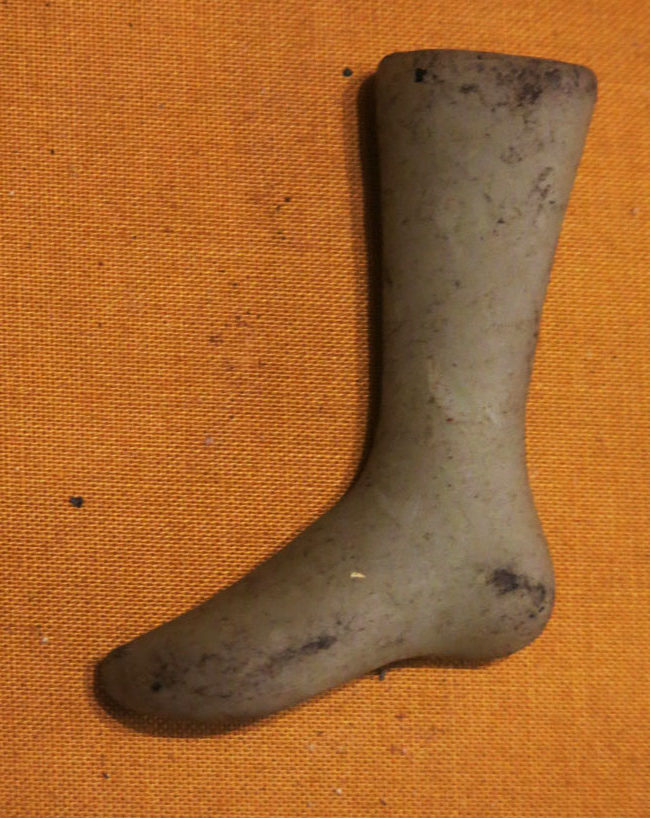
The unusual objects No. 5

Toys of yore: dolls, a boat, and a top
While the Beguinage remains closed for renovation, Erasmus House is putting an unusual object from the vast historical, archaeological, folk art and religious collections of the municipal museums on display each month. This month four toys that were exhibited at the Beguinage have been chosen. They are but a few examples of Anderlecht’s gamerelated collections.
1. Miniature boat
Miniature sailboat – model pond yacht – bearing the letters FF on the wooden sail.
Belgium, 1900-1950
Wood and string
1.5 cm; 9 cm in diam.
inv. n° BEG 6072
2. Top
Round top exhibiting grooves where the string was wound.
Belgium, 1870-1900
Wood
10 x 13 cm
inv. n° BEG 6071
3 Peg wooden doll
Doll with jointed arms and legs from which a part is missing. The plaster was added later.
Painted eyes, mouth, and hair.
Belgium, 1870-1900
Wood
15.5 cm; 4.5 cm in diam.
inv. n° BEG 6109
Many modern children’s toys – Lego, Playmobil, Barbie, and so on – fail to differ from those of the past. Some of them have even existed since prehistoric times, both for girls and for boys. In Pieter Bruegel the Elder’s famous painting, Children’s Games, painted around 1560 (Kunsthistorisches Museum, Vienna), one can see 246 scenes of children running, jumping, and playing. Three of the toys visible in this painting are presented this month in the Erasmus House Museum.
Girls’ games…
Dolls have had a spiritual dimension since the dawn of time, since they are facsimiles of living people and can be cared for and clothed. Made from fabric remnants, bone fragments, wood, or even dried apples, they reflect the fashions of the times in which they are made. An example is this jointed ivory doll from the 2nd or 3rd century of the Common Era that was discovered in Via Valeria in Tivoli (Massimo alle Terme Palace), showing necklaces, bracelets, gold rings, and a hairstyle that go back to Ancient Rome. The oldest dolls were discovered in Egypt, in women’s tombs dating from the 20th century BCE (Louvre Museum). Moreover, the French word “poupée” and the English derivative “puppet” come from the Latin word pupa, meaning a little girl. Their ritual use is indeed attested in Ancient Rome, for when a young woman married, she offered her favourite doll to the goddess Venus, Diana, or Minerva, thereby marking her transition from virgin to wife. On the contrary, if a child died before reaching adulthood, her/his toys were consecrated to the gods of the netherworld, as Vitruvius explains in De Architectura, Book IV.
… and boys’ games
Tops and miniature boats are usually considered boys’ toys. Tops (from the Latin turbo, which also refers to a spiral shell) which have been known since ancient times, belong to the category of trochi, a term referring to any object that moves. Tops are not the same as whipping tops, which are set into motion by a whip, whereas the traction exerted by pulling on the string wound around a top’s axis is what makes the top spin. It was amongst young boys’ favourite games, as attested by Auguste Xavier Leprince’s plate The top and the whipping top, published in a compendium of boys’ games entitled Les Jeux des jeunes garçons (1822). Similarly, small boats abounded throughout the 19th century world. A wooden miniature Viking drakkar was discovered in an exceptionally well-conserved state at digs on a Norwegian site dating back to 1015-1028 (NTNU University Museum).
The toys of the Municipal Museums of Anderlecht
The two dolls on display in the Erasmus House Museum represent two female figures with jointed arms and legs that were doubtless clothed, since one wears remnants of a petticoat. They are peg wooden dolls, also known as Grödner Gliederpuppen, that began being manufactured in Germany and France in the late 19th century. They were composed of wooden parts made in various workshops and were traditionally sold without clothes – little girls were then able to make clothes for them as they fancied. The cheap material and low production costs of these toys, which could be made very quickly, meant that they were within reach of children from poorer families. This type of doll was sold for a sou in France or a penny in Britain, hence the name “penny dolls”. The little boat on exhibit is a model “pond yacht” that was very popular in the 1920s. The toy exhibited here probably dates back to that period. The letters on the sail might refer to the owner of the toy’s initials, to the name of the boat, or to that of its manufacturer. The top, for its part, exhibits deep grooves carved into it for the string used to make it spin.
Four toys on display at the Erasmus House
Research and text
Meggy Chaidron
Acknowledgements
Zahava Seewald
Céline Bultreys
Anne Deckers







